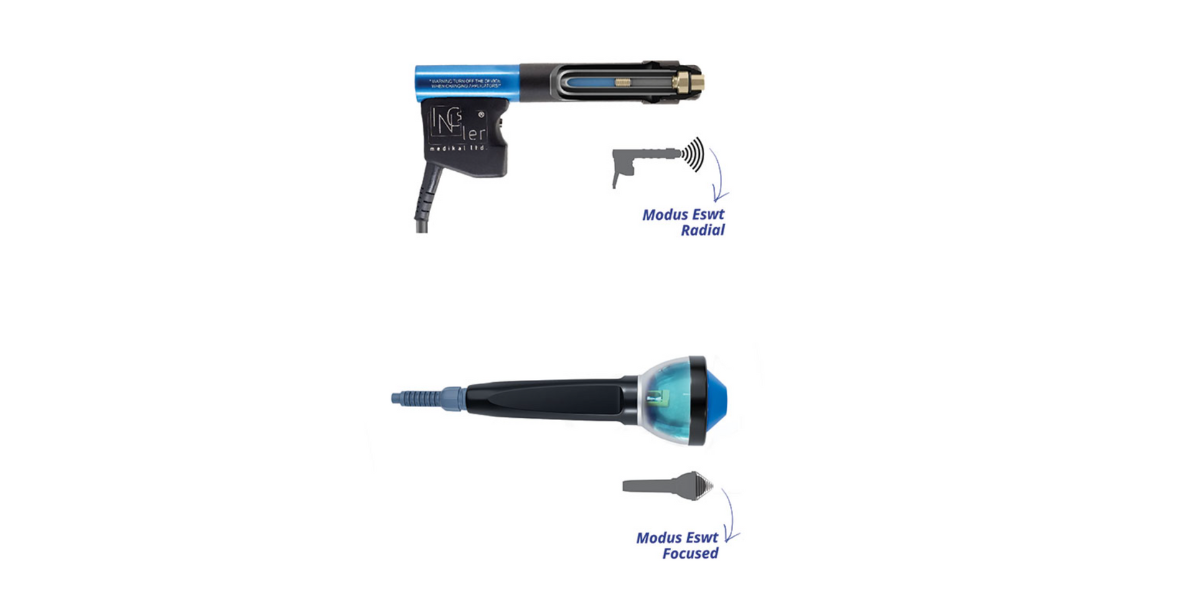Find out more about how this website uses cookies to enhance your browsing experience.
Understanding the Differences Between Focused and Radial Shockwave Therapy

Extracorporeal shockwave therapy (ESWT) has become an increasingly popular treatment for various musculoskeletal conditions, including chronic pain, tendinitis, and sports injuries. There are two main types of ESWT: focused shockwave therapy (F-SWT) and radial shockwave therapy (R-SWT). While both are effective, they differ significantly in their mechanisms, applications, and effectiveness for certain conditions.
Let's break down these differences to help you understand which device might be the best for your clinic.
- Mechanism of Action

Focused Shockwave Therapy (F-SWT):
- F-SWT generates shockwaves that converge at a specific point within the body, allowing the energy to focus on a particular area and therefore highly targeted treatments.
- These shockwaves are high-energy and penetrate deeply, reaching the target tissues with precision.
- The therapy is typically delivered through an electromagnetic, piezoelectric, or electrohydraulic device, each producing focused waves with varying intensities and depths.
Radial Shockwave Therapy (R-SWT):
- R-SWT disperses shockwaves in a broader, radial pattern, meaning the energy spreads out from the source, affecting a wider area.
- The waves generated by R-SWT are lower in energy and do not penetrate as deeply as focused waves.
- Radial waves are typically produced using a pneumatic device, which creates waves that spread out in a cone shape from the point of contact with the skin.
- Depth of Penetration
F-SWT:
- MODUS F-SWT can reach deep into tissues, typically up to 8 cm beneath the skin, depending on the applicator used.
- This deep penetration is particularly useful for treating conditions involving deeper structures, such as deep tendons or bones.
R-SWT:
- Penetrates more superficially, MODUS R-SWT reaches up to only about 4cm into the body.
- Better suited for treating conditions located in more superficial tissues, such as muscle attachments or the surface layers of tendons.
- Precision and Targeting
F-SWT:
- Due to its focused nature, F-SWT is highly precise, targeting specific points of pain or tissue damage.
- This precision makes it ideal for treating localized conditions like plantar fasciitis, calcific shoulder tendinitis, or non-healing fractures.

R-SWT:
- Provides broader coverage, which can be beneficial for conditions involving larger areas or when the exact location of pain is harder to pinpoint.
- Effective for conditions like generalised muscle pain, myofascial trigger points, or large muscle groups where precision is less critical.


- Intensity and Comfort
Shockwave treatments can be uncomfortable for patients but easy adjustment of parameters can make it more tolerable. The MODUS R-SWT device comes with a unique silicon applicator to reduce pain on application by up to 50%. However F-SWT is generally better tolerated by patients with acute presentations.
- Indications and Effectiveness

F-SWT:
- Preferred for conditions that require deep tissue penetration and focused energy delivery.
- Commonly used for treating chronic tendinopathies, deep muscle injuries, and bone-related conditions like non-union fractures.
R-SWT:
- Effective for more superficial conditions and broad areas of pain or discomfort.
- Often chosen for treating conditions like lateral epicondylitis (tennis elbow), achilles tendinopathy, and general muscle soreness.
- Treatment Frequency and Duration
Both MODUS F-SWT and R-SWT come with a suggested treatment protocol of 3-6 treatments carried out weekly however:
F-SWT:
- Typically requires fewer sessions
- MODUS F-SWT offers quicker treatment times vs R-SWT, with treatments averaging 5 minutes in duration
R-SWT:
- Treatment time averages around 10 minutes.
- Minimum of 3 sessions.
- Cost
F-SWT devices are generally more costly than R-SWT due to their increased precision and power but offer effective, tolerable and highly targeted treatments for a wide range of pathologies for specialist clinics.
R-SWT offers a more affordable option yet highly effective evidence-based treatment, making R-SWT the option for many clinicians.
Conclusion
Both focused and radial shockwave therapy have their place in treating musculoskeletal conditions, but their effectiveness depends largely on the nature and location of the condition being treated.
- Focused Shockwave Therapy (F-SWT) is the go-to for deep, localised and bony pathologies where precision is crucial.
- Radial Shockwave Therapy (R-SWT) is more suited for broader, superficial conditions.
Choosing between the two devices will depend on the pathologies which will most commonly be treated and device cost. If you are unsure, contact our team today and they can discuss which modality may be the best fit for your clinic.